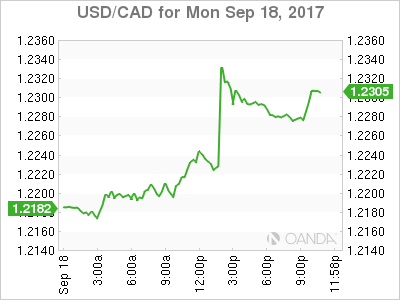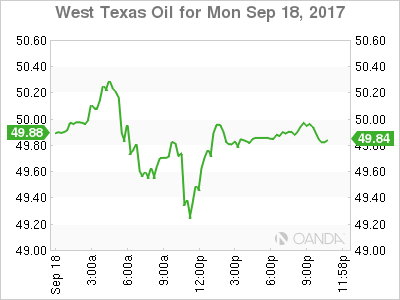The Canadian dollar fell on Monday after the US dollar is trading near the 1.23 price level. The September Federal Open Market Committee (FOMC) meeting kicks off on Tuesday and the market expects that when it ends on Wednesday the US central bank will have officially launched its balance sheet reduction initiative. The fixed income market is also eyeing a higher than 50 percent chance of a US rate hike in December.
Bank of Canada (BoC) Deputy Governor Timothy Lane was the first official to speak after the surprise rate hike in September. The Canadian central bank pivoted from a slightly dovish rhetoric until another Deputy Governor, Carolyn Wilkins spoke about the need to remove some stimulus. The comments were followed by Governor Stephen Poloz and the market got onboard with the rate hike announced in July. Policy makers were quiet since then and while the decision to raise interest rates were not a shock, specially considering the rapid pace of growth of the Canadian economy, the lack of warning from the central bank was an issue with market analyst.
Deputy Governor Lane said that the BoC will monitor how the economy responds to a higher interest rate and a stronger loonie. NAFTA was also addressed by the policymaker on the same day that US Trade envoy Robert Lighthizer said negotiations were moving quickly. Both Mexico and the United States want a fast resolution to the trade deal renegotiation to avoid it creating a political quagmire with upcoming 2018 elections in both countries.
Mexico’s Economy Minister expects the future of the agreement to hinge on trade deficits and rules of origin which will be discussed on the third round of negotiations to take place in Canada at the end of September.

The USD/CAD rose 0.876 percent on Monday. The currency pair is trading at 1.2298 as the USD recovered ahead of the end of the September Federal Open Market Committee (FOMC) on Wednesday. The Fed funds rate futures trading prices are pointing to a rising probability of a rate hike in December, but the move will be dependant on economic indicators release between now and then. The September monetary policy meeting was earmarked by the market early on as the one where the Fed would announce the start of its balance sheet reduction. With so much room to operate given the massive amount of funds accumulated during its QE program, the Fed has wiggle room and both hawks and doves within the FOMC welcome the initiative.
A rate hike in the United States is not as clear cut. Minnesota Fed President Neil Kashkari has become the major dove talking against another rate hike citing weak inflation. GDP growth has surprised to the upside, but inflation and retail sales remain soft and could push the December rate hike into next year, and probably into the mandate of a yet to be named Fed Chair after Fed Chair Janet Yellen’s term expires in February.
The September rate hike in Canada leaves the interest rate back to 1.00 percent, the same level it had in 2015 before the BoC had to proactively cut its rate twice to shield the economy from falling oil prices. The central bank is convinced the economy is strong enough to remove that stimulus, but the strong growth and comments on the strong currency being a reflection of the economy could lead to another rate hike this year

US energy prices are flat at 0.024 percent in the last 24 hours. The price of West Texas Intermediate is trading at 49.81 as energy is trading at a tight range at the top of the week. Seasonal maintenance has reduced demand for crude and stopped the oil rally in its tracks following the impacts of Hurricane Harvey and Irma.
While the Organization of the Petroleum Exporting Countries (OPEC) production cut agreement has managed to stabilize the price of oil, it has failed to spark a sustained recovery of prices. The $50 price level has been a hard one to crack and trade above consistently. US crude inventory reports will continue to show the impact of natural storms, but those effects should be worked out sooner rather than later. Energy markets will continue to trade on the assumption of a larger supply despite disruptions still creating a glut as demand grows at a slower pace.
Market events to watch this week:
Monday, September 18
9:30pm AUD Monetary Policy Meeting Minutes
Tuesday, September 19
8:30am USD Building Permits
Wednesday, September 20
4:30am GBP Retail Sales m/m
10:30am USD Crude Oil Inventories
2:00pm USD FOMC Economic Projections
2:00pm USD FOMC Statement
2:00pm USD Federal Funds Rate
2:30pm USD FOMC Press Conference
6:45pm NZD GDP q/q
11:50pm JPY Monetary Policy Statement
Thursday, September 21
Tentative JPY BOJ Policy Rate
2:30am JPY BOJ Press Conference
8:30am USD Unemployment Claims
Friday, September 22
8:30am CAD CPI m/m
8:30am CAD Core Retail Sales m/m
8:30am All Day NZD Parliamentary Elections













